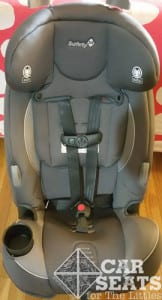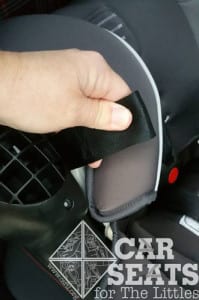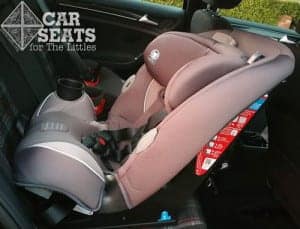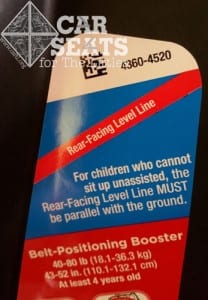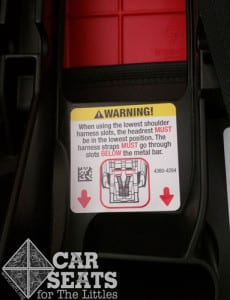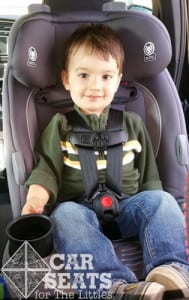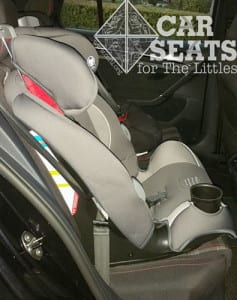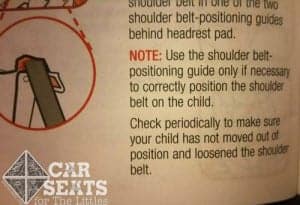Our friends at Safety 1st have taken the lead in child passenger safety by implementing a 2 year old minimum for forward facing use of their convertible car seats. This game-changing minimum started with the lightweight Scenera NEXT, then expanded into the more featured Apt 50, the Grow and Go and now, we see it on the Continuum 3-in-1 car seat.
The phrase 3-in-1 can mean a couple of different things when it comes to car seats: it can either be a forward facing only seat that converts to a high back and backless booster like the Graco Nautilus or Tranzitions, or it can be a seat that rear faces, forward faces, and converts to a high back booster. The Continuum is the latter variety — it rear faces from 5-40 lbs, then forward faces from 22-50 lbs, for a child who is at least 2 years old, and finally converts to a high back booster for children who weigh between 40-80 lbs and who are at least 4 years old. (CSFTL, Inc. recommends a minimum of 5 years for booster use.)
Safety 1st has a number of convertible and multimode seats. We’ve created a handy comparison chart to detail the differences between models.
CSFTL Quick Stats
- Rear facing weight range: 5-40 lbs
- Rear facing height range: 19-40″
- Forward facing weight range: 22-50 lbs
- Forward facing height range: 29-45″
- High back booster weight range: 40-80 lbs
- High back booster height range: 43-52″
- Lowest harness position: 6″ with insert
- Highest harness position: 16.5″
- Highest booster guide position: 18.5″
- Lower anchor weight limit: 40 lbs
Measurements
- Shell height: 26″
- Width at widest point: 18.5″
- Seat pan depth: 12″
- 3 crotch buckle positions: 1 and 2 can be used rear facing only, slots 1, 2, and 3 can be used in forward facing mode
- Weight: 12.5 lbs
Features
- Expiration: 10 years
- No-rethread harness when not using the newborn setting
Installation: Rear Facing
- Weight range: 5-40 lbs
- Height range: 19-40 inches or when the child’s head is above the top of headrest
- Crotch buckle position: 1st or 2nd slot
Lower Anchors: 40 lb weight limit
The Continuum’s cover is easily removed to access the rear facing belt path. This handy feature made the rear facing install pretty simple using either lower anchors. I was able to pull the tail of the anchor’s webbing straight up while pressing down on the seat pan with my non-dominant hand. It didn’t take very much effort to get a solid installation in rear facing mode using the lower anchors.
Seat Belt
My only complaint about the rear facing installation with the seat belt is that the belt path is somewhat narrow. It was a bit challenging to thread the seat belt through both sides of the belt path, though the seat didn’t eat my hands the way other seats have!
My car, a 2016 Volkswagen GTI, has recessed seats that introduced a bit of a unique situation with installing the Continuum. Because the Continuum has a long base, the bottom of the Continuum didn’t quite sit level with the vehicle seat. Usually, we see this type of issue closer to the seat bight but in my car, the gap was under the middle portion of the base of the seat. We were able to get a solid installation despite this gap so it wasn’t too terribly concerning.
Front to back, a fully reclined Continuum (in recline position 3, for younger passengers who cannot sit up on their own) took up roughly 32 inches of space. The more upright position 2 took up roughly 31 inches of space. A vehicle with a flat seat would probably allow for an even more upright installation than this car did. The recline angle is indicated on both sides of the seat with a labelled red line. For children who can sit unassisted, the recline line does not need to be parallel to the ground.
Fit to Child
Rear Facing
The Continuum features a no-rethread harness for all harness positions except for the bottom slot. This 6″ lowest setting is for the tiniest of passengers. Setting up the seat for the smallest setting requires undoing the harness and rethreading it through the lowest set of harness slots, the red plastic piece that goes behind the child’s back, and through the slot holes in the cover. The harness has two sets of loops — a smaller one for use with the lowest harness slot and a larger one for use with the no-rethread harness. The label on the back of the seat reminds caregivers to thread the harness over the metal bar.
Switching between booster mode and this lowest harness setting was a little more challenging than I’d expected — I’d suggest reading the manual first and having it at your side while making the switch.
Preemie doll
Our preemie model is a Huggable Images doll. She’s 4 lbs and 17 inches long. With the required padding behind her, the straps are still just above her shoulders. Since the straps need to be at or below the shoulders for rear facing use, this model is bit too small for the Continuum.
To be fair, the seat’s minimum weight is 5 lbs so she’s below that minimum limit.
Newborn doll
Our newborn model is another Huggable Images doll. She’s 7 lbs and 17 inches tall. With the required padding behind her, the lowest slot is still just above her shoulders. Based on these two models, we’d place the Continuum in the Hit or Miss category for newborn and preemie fit. The very similar but more featured Grow and Go has a much larger infant pad that offers a very good fit for the tiniest of passengers. Caregivers who would like to use a convertible car seat from birth may have more success with the Grow and Go than the Continuum.
7 Weeks Old
This model did his best Blue Steel impression while sleeping through the photo shoot. The straps were on the lowest harness slot and he had the padding (which is required for use with the lowest harness slots but can also be used at any weight) behind him. The Continuum fit him better than it did our doll models.
11 Months Old
This sassy model is 11 months old, she weighs 22 lbs and is 28.5 inches tall. The seat fit her well and she’s got plenty of growing room! The low sides made loading and unloading her a fairly simple task, even when she got a bit squirmy.
2 Years Old
This model is 2 years, 7 months old. He’s 31 lbs and 35 inches tall. He was quite excited to try out this seat for us; we thank him and his family for their help in writing this review. The seat’s low sides made loading him into the car fairly painless. The seat fit him well and he found the padding comfortable. He has plenty of room to grow in the Continuum!
Installation: Forward Facing
- Weight range: 22-50 lbs
- Age range: 2 years and up
- Height range: 29-45 inches or when the child’s ears are above the top of the headrest
- Crotch buckle position: 1st, 2nd, or 3rd slot
Lower Anchors
Installing the Continuum in forward facing mode using the lower anchors was also pretty straightforward. The forward facing belt path is a bit more generously sized than the rear facing belt path so threading the lower anchors through it wasn’t a challenge. The actual installation went pretty smoothly. I set the seat’s base down into the recessed area of my vehicle’s seat; it fit well. To install the seat, I used downward pressure with my non-dominant hand while pulling directly up on the lower anchor’s webbing. I was able to access the lower anchors from outside the seat’s shell during this process.
Seat Belt
The Continuum’s seat pad unsnaps to reveal the forward facing belt path. This allows access to the seat belt, which is super handy! I was able to get a solid installation once the cover was out of the way.
Fit to Child
3 Years Old
This model was happy to show off her ferocious face paint while testing this seat for us! She’s 3 years old, 39 lbs, and 39 inches tall.
The low sides allowed her to climb into the seat easily and she was able to buckle herself in. She found the Continuum comfortable and she’s got plenty of room to grow.
4 Years Old
Here we have a 4 year, 11 month old model. He’s 44 lbs and 44 inches tall. He found the Continuum quite comfortable — we see him telling us all about how much he liked the seat!
The low sides made climbing into the seat simple. He was also able to buckle himself in though he wasn’t able to unbuckle this style of crotch buckle.
6 Years Old
This model is 6 years, 2 months old. She weighs 48 lbs and is 45 inches tall. She’s at the very top of the harnessed mode’s top shoulder height and standing height of 45 inches tall. She’s also just 2 pounds away from the maximum harnessed weight. Though it appears that the harness is coming from just below her shoulders, the padding is pushing it down a bit. The harness emerges from the shell of the seat just above her shoulders, so she still fits safely.
Although this model will outgrow this seat in harnessed mode very soon, she shows off a great feature of this seat: the Continuum’s height and weight limits are quite realistic. An average-sized child could use this seat for their entire harnessed car seat career, then graduate to booster mode at a very reasonable 5-6 years old. While most car seats on the market have an inflated height and weight limit, the Continuum’s realistic limits make it an excellent value in our book.
At the age of 6, and as she is approaching the height limits of this seat, this model is an ideal candidate for using the Continuum in booster mode.
Booster Mode
- Weight range: 40-80 lbs
- Height range: 43-52 inches
- Minimum age: 4 years old. CSFTL recommends waiting until children are at least 5 years old before moving from a harnessed car seat to a booster seat.
The Continuum has a shoulder belt guide but the manual states that it’s only to be used “if necessary to correctly position the shoulder belt on the child.” That’s a bit unique — on most combination and multimode seats, the shoulder belt needs to be threaded through the belt guide.
We found that the shoulder belt would wind up in the shoulder belt guide regardless of if we tried to thread it through the guide or not.
Fit to Child
Booster Mode
Converting the Continuum from harnessed mode to booster mode was pretty simple. When the headrest is in the highest position, the cover unsnaps up to expose a red plastic storage area. The harness tucks behind this plastic piece and the crotch buckle should be removed and stored in a safe place. The manual seems to show a picture of the buckle tongues being stored in the same part of the seat’s shell where the hip straps are anchored but the instructions don’t specify. We were able to tuck them into that location.
We applaud any and all designs that keep the harness attached to the seat while in booster mode — this gives caregivers one fewer thing to keep track of. A dedicated storage location on the seat for the crotch buckle would be a small improvement.
6 Years Old
Here we see our model from earlier. The booster mode offers her a solid belt fit — the shoulder belt hits the middle of her shoulder and the lap belt sits nicely across her upper thighs. The seat’s bulky size makes buckling it in booster mode a bit tricky for this inexperienced booster rider. It only took a couple of trips before she got the hang of buckling herself into the Continuum.
Because the belt guide is already at the top setting for her, we wouldn’t expect this seat to last her terribly long in booster mode.
Important Information: Where to Find
FAA Approval Label: the Continuum is approved for use on airplanes in harnessed mode only. Because airplane seat belts are lap only, booster seats (which require a lap/shoulder belt) are not approved for use on airplanes so the Continuum cannot be used on an airplane in booster mode. This sticker is located on the back of the shell of the seat seat, on the child’s right side.
Date of Manufacture label: this label is found on the outside of the base of the seat, below where the child’s left leg would be positioned.
Lower Anchor storage: the lower anchors store in the rear facing belt path. When installing the Continuum in rear facing mode using the seat belt, be sure that the stored lower anchor webbing doesn’t interfere with the seat belt.
Manual storage: the manual states that the manual stores in the bottom of the base.
Overall Thoughts
The Continuum is basically a Safety 1st Grow and Go with lower height and weight limits, and a lower price. Instead of the 65 lb maximum weight limit of the Grow and Go, the Continuum’s max weight is 50 lbs. The Continuum has a 45 inch maximum height, where the Grow and Go’s max height is 49 inches. On paper, the Grow and Go is a longer lasting seat but we found that the Continuum’s lower limits are quite realistic for most children, making the Continuum a great value!

